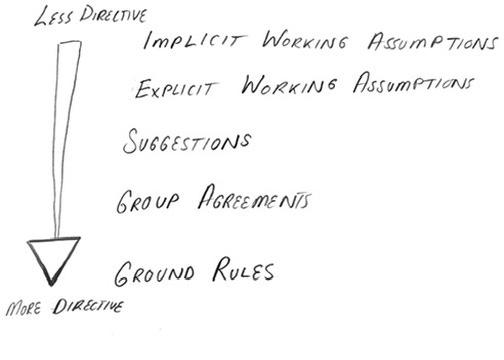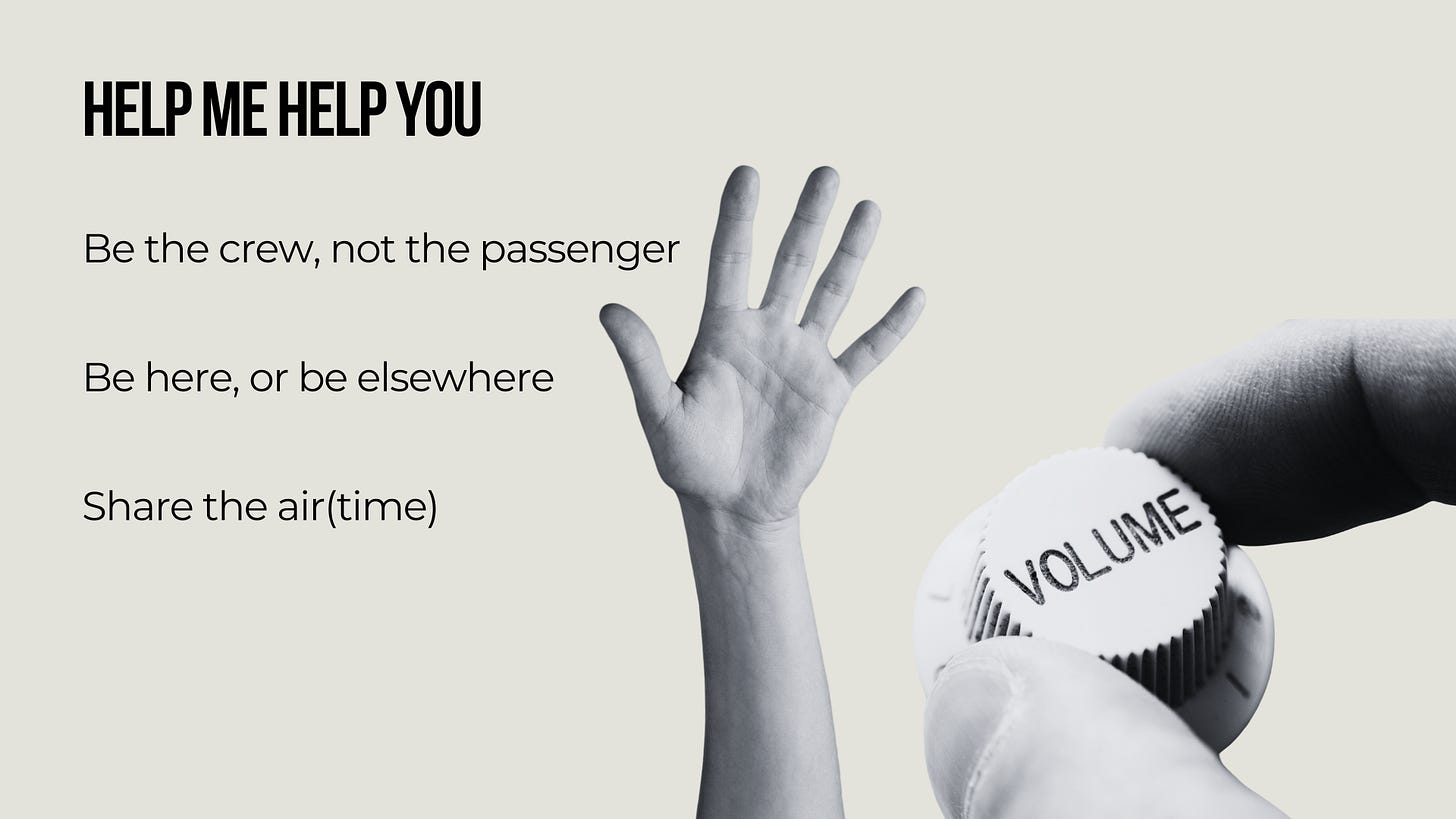G is for... Ground Rules (Part II)
Back to one of the most contentious topics in facilitation-land
In last week’s post, we began unpacking the language behind what people might mean, and how they might interpret the phrase, “ground rule.” I recommend reading that post first.
In today’s post, I unpack how I decide which flavour of collaboration principle I use and show you an example from a recent session.
So how do I decide what to use?
Here’s my approach:
I’ll use rules if psychological safety is scarce. Without safety, there is little point in meeting as a group IMO. Rules alone do not create safety, but they can provide some of the conditions for it. While some participants dislike the language of rules (feels school-y), and I share that instinct, I still use the term in low-safety settings, where stronger structure helps people feel comfortable enough to participate. Over time, my aim is to move beyond needing rules.
I’ll use agreements if the group needs structure and we have the time to build genuine commitments together. Agreements only work if the group truly agrees to them, so it is worth investing time to co-create them rather than imposing them. Co-creating principles can be powerful, but not every group will know what they need. As a facilitator, part of the job is suggesting ideas that genuinely help the group.
I’ll use suggestions as my default with most new groups. They set the tone quickly and allow me to observe how the group naturally works, without imposing too much direction about behaviour up front. Often, groups don’t need formal rules or agreements. Framing desired behaviours as explicit suggestions is sometimes enough to set the tone. This allows space to prove me wrong.
I’ll (sometimes) use working assumptions if the group is ready for deeper reflection. Assumptions (similar to values and beliefs) often do not specify behaviour directly, but they can be powerful if the group is willing to translate beliefs such as “Curiosity leads to understanding” into practical behaviours themselves without needing a facilitator to spell it out for them. They are powerful because they help groups to see underlying beliefs, values and assumptions that are holding them back and they can be useful ways to get started quickly, but like any assumptions, they need testing.
Practical note: Assumptions can be both a blessing and a pitfall. They’re very powerful when well articulated, because the group can interpret them broadly, without the need to spell out every desirable behaviour. The pitfall is that if the group doesn’t understand how a particular behaviour maps to the assumption, it may not be enacted as intended.
Lastly, remember that even if you choose not to articulate any form of collaboration principle, both you and the group will still have working assumptions, they will just be implicit rather than explicit.
Example
Here is an example which I used at a recent event. I introduced them with the phrase: “here’s what I need from you to do my job”.
For context, this was a group with high psychological safety that I was working with for the first time. I picked a mix of process ground rules (how the group should respond to instructions) and a couple of behavioural suggestions.
The hand up signifies that people should stop talking and put their hand up if they see me with my hand up and the volume button is to make a gesture like you are turning up the volume if you can’t hear me (I have a very quiet voice).
Final thoughts
If you don’t make them explicit - implicit rules, agreements or assumptions will guide you.
Every principle is a trade-off. They can encourage positive behaviour, but they may also mask underlying dynamics. The balance you strike depends on the situation. Use as few as you can get away with and all the ones you need.
Groups are usually not ready for everything at once. More advanced rules can be introduced as the group develops. For example, one of the most powerful collaboration principles I’ve ever experienced is Focus on Interests, not Positions. In my experience, it’s also one of the hardest to convey as it’s based on a whole theory.
Drop rules which no longer serve you.
Some rules are there to support you as the facilitator, and that’s perfectly fine — the key is simply being aware that this is their purpose. Some of the resistance to ground rules according to this thread tends to come from very experienced facilitators. If you’re newer to the role, put whatever structures you need in place to feel comfortable and start building your confidence, but it is also worth letting the group surprise you, positively.
Resource Shoutout:
Facilitator School’s Meeting Ground Rules page an excellent resource for ground rule inspiration based on different scenarios.
The Mindset Shift:
Ground rules are not fixed commandments, they are flexible tools that must be chosen with care, context, and honesty about whose needs they serve.
From: Ground rules are a standard step at the start of any session, often borrowed from stock lists or imposed without reflection.
To: Ground rules are intentional choices. They are trade-offs that shape safety, conflict, and participation, and the best ones are co-created, adapted over time, and serve both the group and the facilitator.
P.S. Enjoy this? From this month on, I am working with a small cohort of people to learn how to make their facilitation more impactful on the job!
Instead of learning facilitation in the abstract, we work on the design and delivery of a real workshop you’re running, with hands-on guidance, templates and support from me.
Want to know more? Let’s talk. I have a small number of slots in my calendar for 20 minute call to quickly see if it’s a fit.


